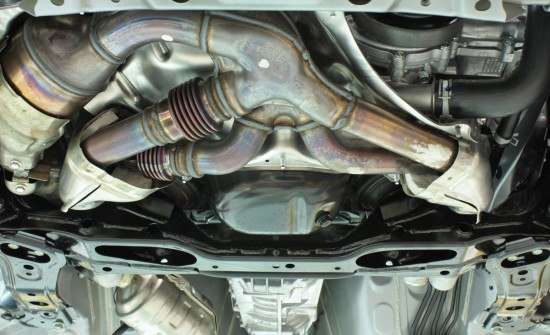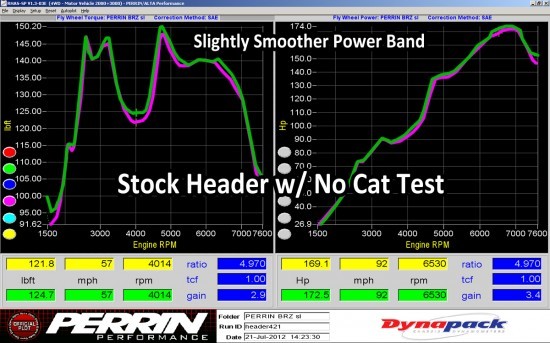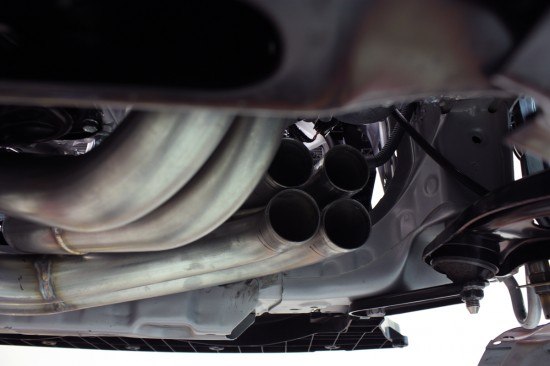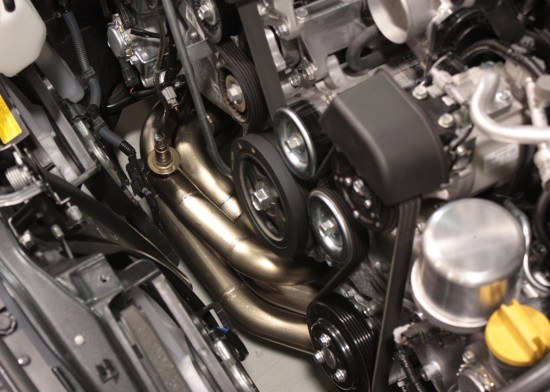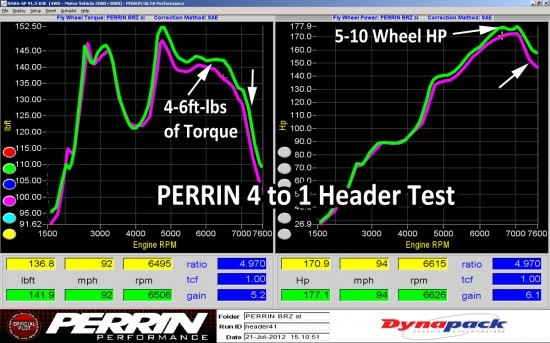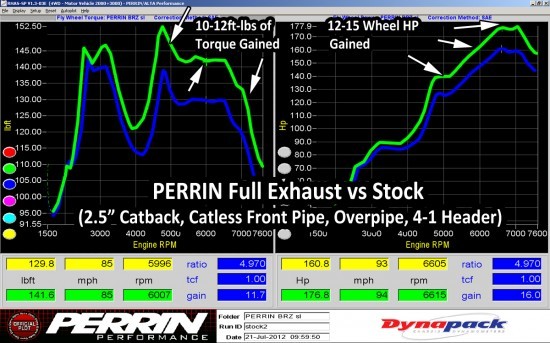Share This
This was the first time we had tested our headers on the dyno. Based on the things we know about the car and some of its variables, we knew it would be key to do this all on the same day as all the other parts. This ensures that the HP gains we saw were legit. After seeing some peoples dyno results showing huge gains of 15-20 WHP I was excited to see what we could do. We started with two designs to see where we would be for HP, then do further tweaking from there.
Continuing from earlier in the day, the car still has all the other exhaust parts we make bolted on to it. This includes our 2.5" catback exhaust, catless 2.5" front pipe and 2.5" Overpipe and NO ECU tuning.
A simple test that I am surprised no other vendors have done is take the stock header and remove the car. The stock header is built pretty good, as its a tri-y design or a 4-2-1 design. The stock header primaries are 1.625" and the secondaries are 1.75". So this is good as it matches the stock exhaust ports and matches what some header calculators say it should be.
One of the flaws I see is with two bends where they merge almost into each other. You can see this on Cylinder #1 and 2 above. The other flaw I see is the cat. Its not a high flow metallic core, but the standard ceramic brick which for sure will cause some restriction. Removing the cat to free up some airflow is a very simple way to see how a properly built 4-2-1 header might perform.
You can see that there are places it gains HP. Overall the HP gains were not huge, but the ECU really liked the header with no cat. We see evidence of this because the HP and TQ was more consistent run to run. Even though the WHP gained wasn't much, but you can see how at higher RPM's the header starts to do pick up some HP. Driving on this for a week or two I also found the same thing in that the engine was smoother and more consistent with a little more top end power. So no cat and only 3 HP?? Is there more to be gained by changing the design? I think there is, but how much?? Larger primaries and smoother bends could net us a few more HP, but that is a future test. This header is short, so some of the header designs rules may not apply, meaning we will just have to keep messing around to find out what works best.
I mentioned how short the header is and with the limited space we had to work with, I thought a 4-1 header (typically freer flowing) would be the better design to start with. We had been road testing our 4-1 header for a couple of weeks and this was up next. This part uses a merge collector and ends in 2.5" tubing. Because this was a very hard part to build equal length, we choose to build this equal volume. The whole idea is that each cylinder has the same back pressure, and this is dictated by volume inside the tubes. So we did this by starting with 1.625" primaries and going to 1.75" primaries. This transition is where the volume is varied. Its not perfect, but neither are more equal length headers as they all don't have equal bends.
The HP results were much better than the OEM 4-2-1 header with no cat. The engine ran smoother and the run to run variance was even better. Of all the tests, this one showed the most promise. There was still some tweaking to be had with the equal length, the equal volume, ECU tuning and other future parts to back it up.
You can see how the TQ dip got slightly narrower compared to previous runs. There is also a very soild 5-8 WHP gained from the 5000-7000RPM area. Again with this header there are really good signs of HP gains at redline.
Are we done with the header tests? Not at all. Revisions to both styles are being made to prove (or disprove) them until we can settle on one type that makes the most sense for us to make.
The below graph shows the car in stock HP form and then with all our exhaust parts bolted on. This includes our 2.5" catback exhaust, 2.5" catless front pipe, 2.5" overpipe and the 4-1 catless header and again with no ECU tuning.
One of the more noticeable things is how the torque dip gets narrower and narrower. Each part we bolted on seemed to help a little. This is really good as when we did some ECU tuning (on the stock car) we were able to also narrow the TQ dip by about 300 RPM. It will be interesting to see how tuning on this setup will effect HP even more!
Final Notes About Results
I know people are thinking you need back pressure to make HP. This is not really true. People also might be thinking that removing restriction lowers low end power for top end power. Again, this is not true. You can see by all the dyno graphs that this NEVER happens at any stage of parts installed. So adding a cat to this test isn't necessarily going to help make HP.
You may be asking, where is the cat! If you are concerned about emissions, keep your stock header. In this application, we will not be using one of the high flow metallic cats we use in thousands of other parts. There is no way these will hold up to the EGT's and abuse that can occur being that close to the exhaust ports. We have lots of experience using these in these types of applications, and they get lose, stop converting properly in 2-3 years time, and then throw check engine lights. Its not a matter of warranty as the manufacture will not cover them always stating "EGT's got too hot" or its not approved for that application. Stepping up and buying an even more expensive cat isn't an answer either. Adding a couple hundred dollars to a header that won't add additional power isn't going to sell headers. I am only mentioning this because many people use the same high quality cats from Magnaflow. Our opinion is there is no sense in adding this huge expense to a part to only have it fail. Or for that matter adding a huge expense to a part only to have it hold back HP!
ECU Tuning
I am sure the first question is, "Why was there no ECU tuning?". For all these tests we flashed the car to stock and only changed the redline. This was done for run time reasons. This is because our dyno allows us to change the run time and we wanted the runs to all have the same run time, as well as have the same amount of time spent during all RPM points. For instance, say each run takes 12 seconds (we can adjust this) then we did a run at 20 seconds it would show less HP because of heat soak. Also doing 8 second runs might show more HP overall. As long as this is consistent run to run it doesn't matter. After testing all the parts we had intended to do runs with the ECU running our stage 1 mapping and then retest them all over again. Since we bump up the redline on our tuned maps, this could effect HP readings as the run would still take 12 seconds, but it would be passing through the RPM's quicker. This would potentially effect HP readings by making them higher than they should be. This may only be a couple of HP but it all adds up. Why are we saying all this? Just to provide all our customers with accurate results and to provide as many details as possible.
So to recap, with NO ECU tuning we gained about 18 WHP, with ZERO loss in HP anywhere. That is actually pretty good for roughly $2500 in parts. This is also very good considering that there are tons of aftermarket parts on the horizon that will help support all these parts. Cams, valve springs, pistons rods, are months away from being tested and tuned. Who knows what kind of results we will see then!



